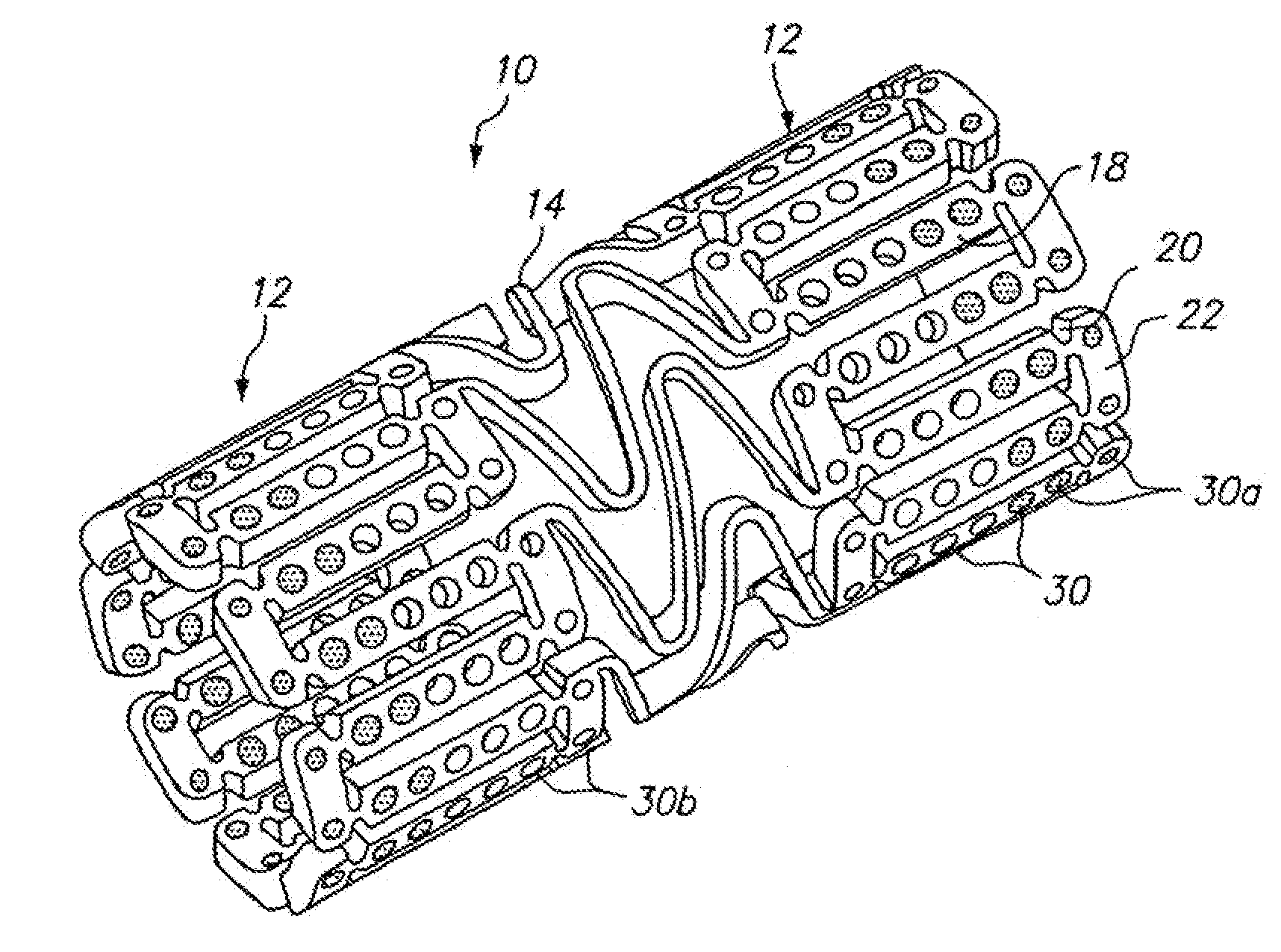Adhesion promoting temporary mask for coated surfaces
a technology of adhesive and surface, applied in the field of tissue-supporting medical devices, can solve the problems of increasing trauma and risk to patients, reducing the mechanical expansion properties of the stent, and increasing the risk of restenosis, and achieving the effect of reducing the effective wall thickness of the sten
- Summary
- Abstract
- Description
- Claims
- Application Information
AI Technical Summary
Benefits of technology
Problems solved by technology
Method used
Image
Examples
example 1
[0079]FIG. 7 illustrates a dual drug stent 700 having an anti-inflammatory agent and an antiproliferative agent delivered from different holes in the stent to provide independent release kinetics of the two drugs which are specifically programmed to match the biological processes of restenosis. According to this example, the dual drug stent includes an anti-inflammatory agent pimecrolimus in a first set of openings 710 in combination with the antiproliferative agent paclitaxel in a second set of openings 720. Each agent is provided in a matrix material within the holes of the stent in a specific inlay arrangement designed to achieve the release kinetics illustrated in FIG. 8. Each of the drugs are delivered primarily murally for treatment of restenosis.
[0080]As illustrated in FIG. 7, pimecrolimus is provided in the stent for directional delivery to the mural side of the stent by the use of a barrier 712 at the luminal side of the hole. The barrier 712 is formed by a biodegradable po...
example 2
[0085]According to this example, the dual drug stent includes the Gleevec in the first set of openings 710 in combination with the antiproliferative agent paclitaxel in the second set of openings 720. Each agent is provided in a matrix material within the holes of the stent in a specific inlay arrangement designed to achieve the release kinetics illustrated in FIG. 8.
[0086]The Gleevec is delivered with a two phase release including a high initial release in the first day and then a slow release for one to two weeks. The first phase of the Gleevec release delivers about fifty percent of the loaded drug in about the first twenty-four hours. The second phase of the release delivers the remaining fifty percent over about one-two weeks. The paclitaxel is loaded within the openings 720 in a manner which creates a release kinetics having a substantially linear release after the first approximately twenty-four hours, as illustrated in FIG. 8 and as described above in Example 1.
[0087]The amo...
example 3
[0088]According to this example, the dual drug stent includes the PKC-412 (a cell growth regulator) in the first set of openings in combination with the antiproliferative agent paclitaxel in the second set of openings. Each agent is provided in a matrix material within the holes of the stent in a specific inlay arrangement designed to achieve the release kinetics discussed below.
[0089]The PKC-412 is delivered at a substantially constant release rate after the first approximately twenty-four hours, with the release over a period of about four to sixteen weeks, preferably about six to twelve weeks. The paclitaxel is loaded within the openings in a manner which creates a release kinetic having a substantially linear release after the first approximately twenty-four hours, with the release over a period of about four to sixteen weeks, preferably about six to twelve weeks.
[0090]The amount of the drugs delivered varies depending on the size of the stent. For a three mm by six mm stent the...
PUM
| Property | Measurement | Unit |
|---|---|---|
| Time | aaaaa | aaaaa |
| Distance | aaaaa | aaaaa |
| Energy | aaaaa | aaaaa |
Abstract
Description
Claims
Application Information
 Login to View More
Login to View More - R&D
- Intellectual Property
- Life Sciences
- Materials
- Tech Scout
- Unparalleled Data Quality
- Higher Quality Content
- 60% Fewer Hallucinations
Browse by: Latest US Patents, China's latest patents, Technical Efficacy Thesaurus, Application Domain, Technology Topic, Popular Technical Reports.
© 2025 PatSnap. All rights reserved.Legal|Privacy policy|Modern Slavery Act Transparency Statement|Sitemap|About US| Contact US: help@patsnap.com



